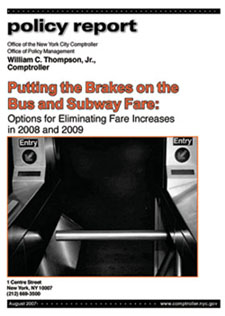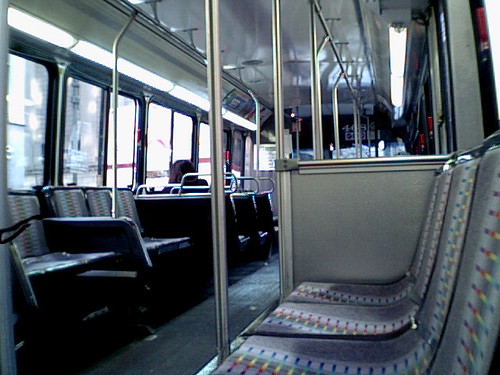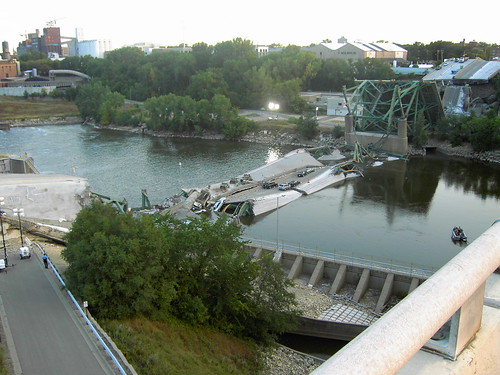 During the morning panic as yesterday’s subway deluge set in, the tracks weren’t the only part of the MTA flooded. Its Website was overwhelmed with visitors — 44 million of them in a few hours, according to some sources — and the system just couldn’t handle the pressure.
During the morning panic as yesterday’s subway deluge set in, the tracks weren’t the only part of the MTA flooded. Its Website was overwhelmed with visitors — 44 million of them in a few hours, according to some sources — and the system just couldn’t handle the pressure.
With this outage, bloggers and reporters across New York are noting something I noticed in July when their site went down during the East Side power outage. Similarly, Todd has long railed against the oft-down MTA Website on his own site and in the comments section of mine.
Now, with another big rain storm on the horizon, the MTA is readying its system both online and off. This afternoon, MTA CEO Elliot “Lee” Sander spoke about the emergency plans in place for Friday.
“We will be strategically placing pumps throughout the system at potentially flood-prone locations, strategically placing management and customer personnel at key stations throughout the system to help our customers navigate in case of service disruptions,” he said. “We’ll be adding additional support personnel — such as signal ventilation and drainage maintainers — so that we can immediately address any situations that may arise.”
This all sounds great for those tracks such as the ones underneath Queens Boulevard that are prone to flooding, but what of the glorious Internets? In a post noting how hard it is to navigate the MTA’s Website (something I’ve long since chalked up to the ills of bureaucracy), Chan found some folks at the MTA willing to talk about the site:
On Wednesday, the authority’s Web site recorded 44 million hits…according to Wael Hibri, the authority’s chief information officer. But an untold number of riders were unable to reach the site because the authority was using an old firewall. Mr. Hibri said the authority had scheduled an upgrade of the firewall; the upgrade is to occur this weekend.
Mr. Hibri said the authority had more than enough server capacity to handle the demand. It was the old firewall, he said, that hindered many people from entering the site.
The M.T.A.’s Web site is one of the busiest in the country, [an MTA Executive Director Christopher P.] Boylan said…During the height of the transit chaos on Wednesday morning, Mr. Hibri said, the site got 3.8 million hits. By comparison, the authority got about 2 million hits an hour during a brief power failure in parts of Manhattan and the Bronx on June 27.
So while Sander has men in the tracks ready to pump out the subway, Hibri is relying on the old wing-and-a-prayer method. After all, the same firewall in place on Wednesday won’t be upgraded until this weekend at the earliest.
Friday is bound to be another taxing day for the MTA’s site. As soon as the first drops fall, people at their desks across the city will flock to MTA.info expecting the worst for the subway systems after Wednesday’s debacle. It sounds like that old firewall might once again stifle traffic.
We’ll find out later if millions of New Yorkers trying to will their way to an easy start to their weekends once again overwhelms the MTA. Good luck to them.
Meanwhile, if the MTA’s firewall blocks you out, I’ll have all of the service alerts, and I’ll be updating them as often as possible. So check back early and often when the rains fall. Or just chead on over to Chris’ site. He has all the MTA alerts you’ll ever need.

 City Comptroller William C. Thompson, Jr., tried to help out the straphangers, but the weather would have none of that. Literally lost in yesterday’s flood was his report proclaiming the impending MTA fare hike could be avoided if
City Comptroller William C. Thompson, Jr., tried to help out the straphangers, but the weather would have none of that. Literally lost in yesterday’s flood was his report proclaiming the impending MTA fare hike could be avoided if  trains are suspended in both directions between the South Ferry Station and the Chambers Street Station.
trains are suspended in both directions between the South Ferry Station and the Chambers Street Station. and
and  trains rains have resumed service but with residual delays.
trains rains have resumed service but with residual delays. trains are suspended in both directions between the 86th Street Station and the Brooklyn Bridge-City Hall Station.
trains are suspended in both directions between the 86th Street Station and the Brooklyn Bridge-City Hall Station. trains are running shuttle train service in both directions between the East 180th Street Station and the Dyre Avenue Station, and suspended in both directions between 86th Street and Bowling Green.
trains are running shuttle train service in both directions between the East 180th Street Station and the Dyre Avenue Station, and suspended in both directions between 86th Street and Bowling Green. trains are suspended in both directions between the 59th Street/Lexington Avenue Station and the Brooklyn Bridge-City Hall Station.
trains are suspended in both directions between the 59th Street/Lexington Avenue Station and the Brooklyn Bridge-City Hall Station. trains are running. (We have a winner! Back to normal first.)
trains are running. (We have a winner! Back to normal first.) trains are running local.
trains are running local. trains are suspended in both directions between the Brighton Beach Station and the 145th Street Station.
trains are suspended in both directions between the Brighton Beach Station and the 145th Street Station. trains are suspended in both directions between the Euclid Avenue Station and the 168th Street Station.
trains are suspended in both directions between the Euclid Avenue Station and the 168th Street Station. train service has resumed with residual delays.
train service has resumed with residual delays. trains are suspended in both directions between the 21st Street-Queensbridge Station and the Forest Hills-71st Avenue Station.
trains are suspended in both directions between the 21st Street-Queensbridge Station and the Forest Hills-71st Avenue Station. trains are suspended in both directions between the Queens Plaza Station and the Jamaica-179th Street Station.
trains are suspended in both directions between the Queens Plaza Station and the Jamaica-179th Street Station. trains are suspended in both directions between the Long Island City-Court Square Station and the 4th Avenue-9th Street Station.
trains are suspended in both directions between the Long Island City-Court Square Station and the 4th Avenue-9th Street Station. trains are suspended in both directions between the 2nd Avenue Station and the Forest Hills-71st Avenue Station.
trains are suspended in both directions between the 2nd Avenue Station and the Forest Hills-71st Avenue Station. Franklin Avenue Shuttle trains are suspended in both directions between the Prospect Park Station and the Franklin Avenue Station.
Franklin Avenue Shuttle trains are suspended in both directions between the Prospect Park Station and the Franklin Avenue Station. trains are running with residual delays.
trains are running with residual delays. trains are running with residual delays.
trains are running with residual delays. trains are running with residual delays.
trains are running with residual delays. trains are running with residual delays.
trains are running with residual delays. trains are operating via the
trains are operating via the  trains are suspended in both directions between the 57th Street-7th Avenue Station and the Forest Hills-71st Avenue Station.
trains are suspended in both directions between the 57th Street-7th Avenue Station and the Forest Hills-71st Avenue Station. trains are suspended in both directions between the Astoria-Ditmars Boulevard Station and the Whitehall Street Station.
trains are suspended in both directions between the Astoria-Ditmars Boulevard Station and the Whitehall Street Station. Two weeks after the MTA announced a
Two weeks after the MTA announced a  Did you know that New York City has a fourth airport that, once upon a time, was designated the next major Metropolitan-area airport? Well, so much for that plan.
Did you know that New York City has a fourth airport that, once upon a time, was designated the next major Metropolitan-area airport? Well, so much for that plan.


 After a thorough review, New York City Transit has released two reports about
After a thorough review, New York City Transit has released two reports about